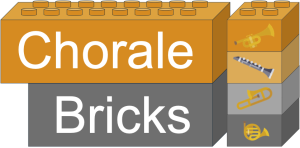The ChoraleBricks Dataset

Welcome to the accompanying website for the ChoraleBricks dataset. On this website, we give an overview of the recordings provided in the dataset. In the table below, pick a piece from the dataset and explore the corresponding multitrack recordings on your own. Using a web-based multitrack player, you have the possibility to create your own mixes by soloing and muting different tracks.
If you use ChoraleBricks in your research, please cite the following paper:
- Stefan Balke, Axel Berndt, and Meinard Müller
ChoraleBricks: A Modular Multitrack Dataset for Wind Music Research
Transaction of the International Society for Music Information Retrieval (TISMIR), 8(1): 39–54, 2025. PDF Details Demo DOI@article{BalkeBM25_ChoraleBricks_TISMIR, author = {Stefan Balke and Axel Berndt and Meinard M{\"u}ller}, title = {{ChoraleBricks}: {A} Modular Multitrack Dataset for Wind Music Research}, journal = {Transaction of the International Society for Music Information Retrieval ({TISMIR})}, volume = {8}, number = {1}, pages = {39--54}, year = {2025}, doi = {10.5334/tismir.252}, url-pdf = {2025_BalkeBM_ChoraleBricks_TISMIR_ePrint.pdf}, url-demo = {https://www.audiolabs-erlangen.de/resources/MIR/2025-ChoraleBricks}, url-details={https://transactions.ismir.net/articles/10.5334/tismir.252} }
Abstract
Concert band and wind music are deeply embedded in society and play a significant role in cultural landscape of many countries, including Germany and Austria, particularly within the amateur music scene. However, this type of music, as well as research on wind and brass instruments in general, remains largely overlooked in the field of Music Information Retrieval (MIR).
In this paper, we address this underexplored area by introducing ChoraleBricks, a framework featuring multitrack recordings of ten different chorales, each comprising four musical parts: soprano, alto, tenor, and bass. At its core, ChoraleBricks provides isolated recordings of individual parts performed by a diverse selection of wind instruments, including flute, oboe, clarinet, trumpet, saxophone, baritone, trombone, and tuba. These isolated recordings act as building blocks or ``bricks'' that can be modularly superimposed to create full mixes with varying instrumentations.
In addition, ChoraleBricks provides sheet music, time-aligned symbolic music representations, conducting videos, and reference annotations such as fundamental frequencies and note events. The framework is further enhanced by Python software tools that support parsing, mixing, annotation, and modular combination of the recorded audio material.
With all multimedia and software components available as open-source, ChoraleBricks provides a versatile framework for generating and augmenting datasets for polyphonic wind music. It supports systematic experimentation and facilitates evaluation across various research topics, including multi-pitch estimation, note transcription, audio alignment, and music education applications.
Dataset
The table below lists the available works. To give you an impression of the recordings, we’ve included a reference mix of a quartet. These mixes incorporate volume adjustments, panning, reverb, and compression. By clicking the title, you can create your own mix using the raw audio recordings provided in the downloads section below.
| # | ID | Name | Year | Dur. | Ref. Mix |
|---|---|---|---|---|---|
| 1 | AN1 | Anonymous: Aus meines Herzens Grunde | 1598 | 00:57 | |
| 2 | BA1 | Bach, J. S.: Ich steh' an Deiner Krippe hier | 1736 | 00:45 | |
| 3 | CR1 | Crüger, J.: Auf, auf, mein Herz, mit Freuden | 1647 | 00:48 | |
| 4 | DR1 | Drese, A.: Jesu, geh voran | 1698 | 00:32 | |
| 5 | GE1 | Gesius, B.: Befiehl Du Deine Wege | 1603 | 00:45 | |
| 6 | GE2 | Gesius, B.: Du Friedensfürst, Herr Jesu Christ | 1601 | 00:34 | |
| 7 | JA1 | Jan, M.: Du großer Schmerzensmann | 1668 | 00:40 | |
| 8 | TE1 | Telemann, G. P.: Der lieben Sonne Licht und Pracht | 1730 | 00:59 | |
| 9 | VU1 | Vulpuis, M.: Die helle Sonn leucht' jetzt herfür | 1609 | 00:16 | |
| 10 | VU2 | Vulpuis, M.: Christus, der ist mein Leben | 1609 | 00:26 |
Note: The listed composers are the composers of the melody, but the four-part harmonization is always by Rudolf Mauersberger.
Downloads
- Data: doi.org/10.5281/zenodo.15081740
- Python toolbox: github.com/stefan-balke/choralebricks
- YouTube playlist: "https://youtube.com/playlist?list=PLpaL3fT5fH2p15yUDCDzopBPaXj5W718Z"
Further Resources
- Photographs from the recordings
- Tutorial: How to extend the dataset
- Common Annotation Errors
- MEI Version of the "Neues Thüringer Choralbuch"
License
 The data provided on this website is licensed under a Creative Commons Attribution 4.0 International License.
Sheet music is published with the kind permission of the rights holder.
If you publish results obtained using this data, please cite the paper mentioned above.
The data provided on this website is licensed under a Creative Commons Attribution 4.0 International License.
Sheet music is published with the kind permission of the rights holder.
If you publish results obtained using this data, please cite the paper mentioned above.
Acknowledgments

This work was funded by the Deutsche Forschungsgemeinschaft (DFG, German Research Foundation) under Grant No. 500643750 (MU 2686/15-1) and under Grant No. 555525568 (MU 2686/18-1). The International Audio Laboratories Erlangen are a joint institution of the Friedrich-Alexander-Universität Erlangen-Nürnberg (FAU) and Fraunhofer Institute for Integrated Circuits IIS.

